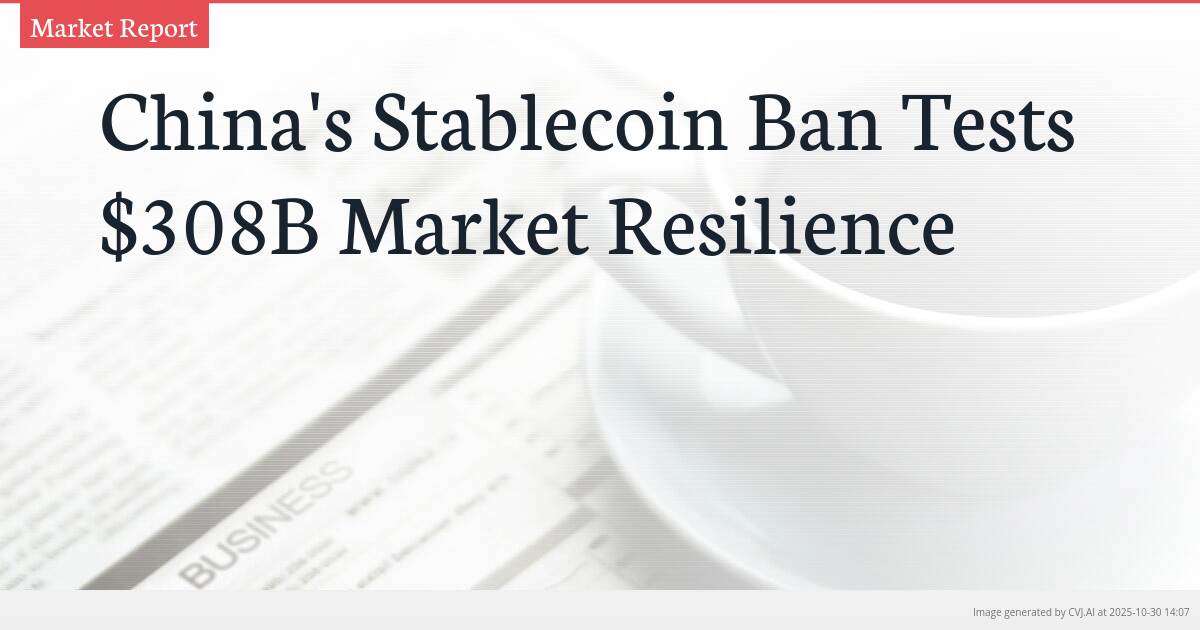This summary text is fully AI-generated and may therefore contain errors or be incomplete.
Introduction
As China’s central bank governor Pan Gongsheng reaffirms the country’s hardline stance against stablecoins, labeling them a ‘new source of vulnerabilities’ threatening global financial stability, the global stablecoin market has paradoxically surged to $308 billion in capitalization. This dramatic growth, occurring despite Beijing’s decade-long restrictions, raises fundamental questions about whether dollar-pegged digital assets can achieve true global scale without participation from the world’s largest fintech economy, or if China’s absence is paradoxically strengthening the market’s independence and resilience.
Key Points
- Global stablecoin market capitalization has grown by $100 billion since January 2024 to reach $308 billion
- Japan has legalized fiat-backed stablecoins with the first compliant yen-denominated token launching on multiple blockchains
- Chinese investors continue using dollar-pegged stablecoins through offshore exchanges despite the official ban
Beijing's Unwavering Stance Against Stablecoins
At a recent financial policy forum, Pan Gongsheng, governor of the People’s Bank of China (PBoC), delivered China’s clearest position yet on stablecoins, describing them as a ‘new source of vulnerabilities’ within the global financial system. His warnings highlighted specific concerns about how these digital assets could undermine monetary sovereignty in smaller economies and enable illicit financial flows including money laundering, illegal cross-border fund transfers, and terrorist financing. According to Pan, most stablecoin projects fail to meet basic compliance standards such as customer identification and anti-money-laundering checks, amplifying what he characterized as loopholes in global financial regulation.
These remarks reinforce China’s decade-long policy of keeping private digital currencies and stablecoins off-limits, even as Beijing continues to advance its state-controlled digital yuan (e-CNY) as a sovereign alternative. The consistency of China’s position creates a stark contrast with global financial trends, particularly as tokenized finance accelerates worldwide. The fundamental question emerging from this divergence is whether stablecoins can truly thrive without access to China’s massive digital economy, which includes payment platforms like Alipay and WeChat Pay that process more transactions annually than many entire regions combined.
Global Stablecoin Adoption Defies Chinese Restrictions
Despite China’s persistent restrictions, global stablecoin adoption has experienced explosive growth. According to data from DeFiLlama, the sector’s total market capitalization recently crossed $308 billion, representing an expansion of nearly $100 billion since January 2024 alone. This remarkable growth is complemented by transaction volume data from venture capital firm A16z, which shows the sector processed over $46 trillion in transactions over the past year—a figure that rivals established payment giants like Visa when adjusted for legitimate activity.
Chris Dixon, a partner at A16z, captured the sector’s maturation, stating: ‘Stablecoins have gone mainstream. [They] have found product-market fit, rivaling the world’s largest payment networks in transaction volume.’ This assessment reflects how stablecoins have evolved from speculative instruments into regulated infrastructure for payments, remittances, and on-chain treasury management. Major financial institutions from PayPal to Western Union are now rolling out their own tokenized settlement assets, while legislative efforts like the GENIUS Act in the United States signal growing formal oversight.
The technology’s maturation beyond its early crypto-native roots is particularly evident in Asia, where governments that once echoed Beijing’s caution are now moving in the opposite direction. Japan has legalized fiat-backed stablecoins this year, with fintech firm JPYC Inc. launching the first fully compliant yen-denominated token on Ethereum, Avalanche, and Polygon. Similarly, other leading jurisdictions including South Korea, Hong Kong, and Singapore are preparing regulatory frameworks to license issuers and protect consumers, creating a diversified, regulation-aware market that functions independently of China’s participation.
The Parallel Systems: Digital Yuan Versus Dollar-Pegged Tokens
As the global stablecoin market expands without China, two parallel financial systems are emerging: an open, market-driven ecosystem led by dollar-backed tokens like USDT, and a closed, sovereign digital-currency model built around China’s e-CNY. This divergence creates a fundamental schism in the future of digital payments, with China’s absence limiting stablecoins’ access to one of the world’s largest pools of fintech innovation and global trade settlement capacity.
In practice, however, China’s ban has not eliminated stablecoin activity within its borders but merely pushed it underground. Chinese investors and businesses continue using dollar-pegged tokens through offshore exchanges and private over-the-counter desks to move funds internationally or hedge against yuan volatility. This underground usage demonstrates how stablecoins remain a quiet instrument of capital mobility within Chinese networks, suggesting that even strict policy cannot completely suppress the appeal of programmable money.
Thriving Without China: Resilience Through Independence
Paradoxically, China’s decision to stand apart from the global stablecoin ecosystem may be strengthening the case for decentralized finance. By refusing to integrate, Beijing is forcing the rest of the world to build independent infrastructure, resulting in a more diversified and institutionally supported market. Stablecoins have become indispensable to global liquidity, powering decentralized exchanges, tokenized bond markets, and US Treasury instruments despite regulatory uncertainty, cyberattacks, and central-bank skepticism.
Each expansion of the $308 billion market reinforces stablecoins’ staying power and proves that the concept of a borderless digital dollar can survive without China’s approval. The technology has matured to function as the core liquidity layer of decentralized finance and the backbone of on-chain commerce, enabling instant settlement across thousands of platforms. While thriving without China has proven possible, achieving true global interoperability between Western and Eastern payment systems would require China’s eventual participation, whether through regulated stablecoin adoption or technical bridges between the e-CNY and compliant dollar-pegged tokens.
The long-term picture remains nuanced: without China, stablecoins lose access to massive scale, but with it, they could achieve unprecedented global reach. For now, the market’s continued growth demonstrates that while China’s absence creates limitations, it doesn’t prevent functionality. The quiet participation of Chinese investors shows that demand persists despite official restrictions, suggesting that the technology’s fundamental value proposition—borderless, programmable money—transcends political boundaries and may eventually compel broader acceptance.
📎 Read the original article on cryptoslate.com

